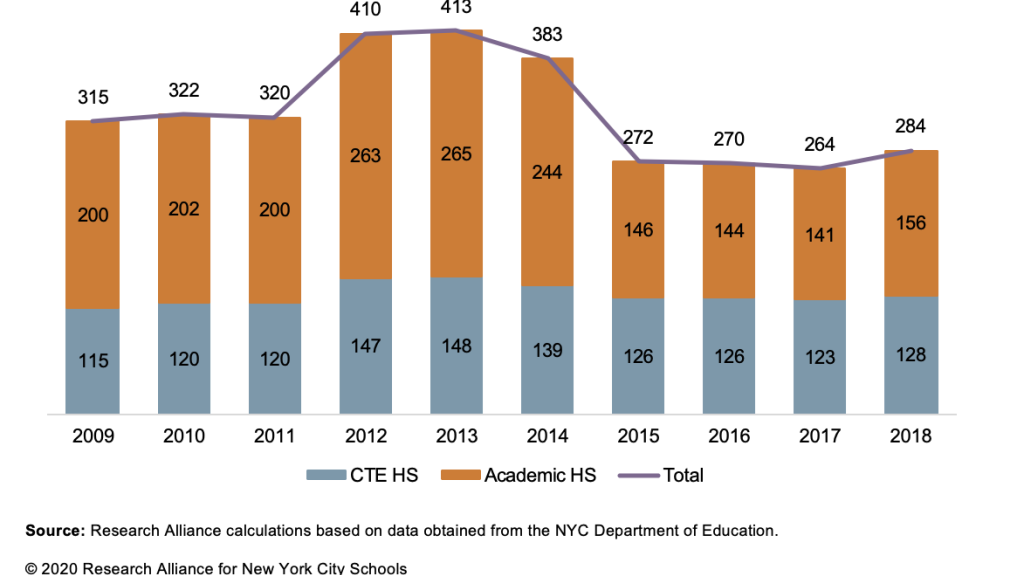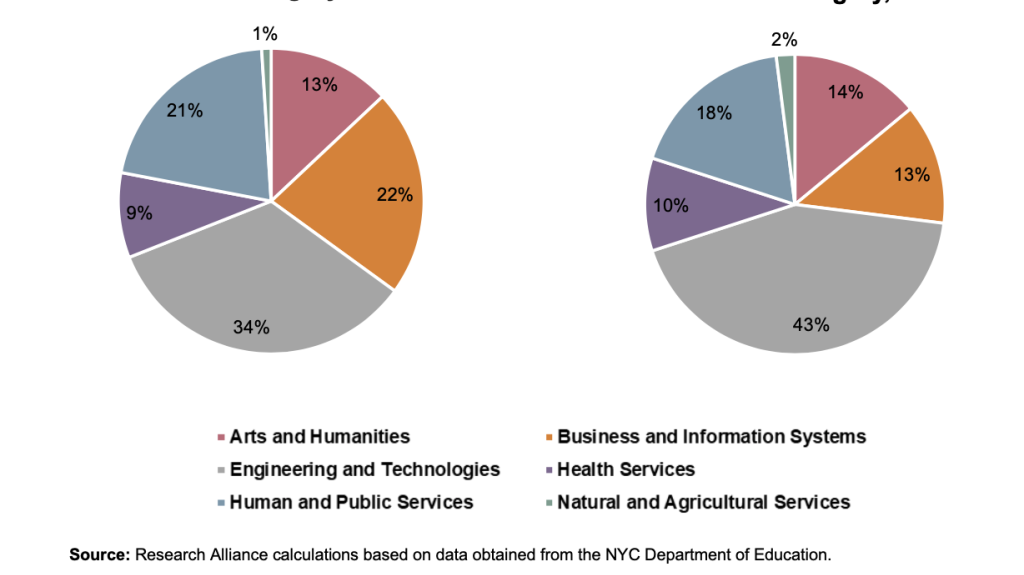In recent years, there’s been an increased focus on Career and Technical Education (CTE) in public schools across the country. Many states and school districts have invested in CTE programs aimed at preparing students for both college and a career after high school. As home to one of the largest and most diverse systems of CTE programs in the country, New York City provides a unique opportunity to learn about CTE innovation on a large scale, and the conditions under which CTE programs are most effective.
Drawing on early findings from an ongoing Research Alliance study, this post examines the City’s changing supply of CTE programs during the last decade. CTE programs in NYC are offered in two main settings: high schools that are dedicated to providing all enrolled students with a sequence of CTE courses, and traditional academic high schools where CTE is one of a range of options. (Students access programs in both types of schools through a universal high school choice process.)
To receive certification from New York State, CTE programs must:
- Provide a sequence of courses organized around a specific career theme and led by certified CTE teachers;
- Engage with business and industry representatives about their program;
- Connect students to postsecondary education or training;
- Create opportunities for students to learn about work; and
- Assess students’ technical skills.
Generally speaking, CTE programs in NYC aspire to meet these criteria, but not all of the programs included in our study have been state certified.
As described below, the landscape of CTE programs in NYC has shifted considerably during the last decade—including changes in the number of programs being offered, the proportion of programs in CTE-dedicated versus traditional academic high schools, and the representation of various career themes within the City’s CTE portfolio.
The Number of CTE Programs
As shown in Figure 1, the total number of CTE programs in NYC increased dramatically between 2009 and 2013. This included growth in CTE-dedicated high schools (where the number of programs increased from 115 to 148), and in general academic high schools (where the number of programs grew from 200 to 265). During this period, about 65 percent of CTE programs were in general academic high schools (note that some schools offer multiple CTE programs).
Beginning in 2013, the NYC Department of Education enhanced its systems for documenting CTE program quality. This work put the district in a position to provide technical assistance and support to CTE programs that were progressing toward mandated standards of practice, and to remove programs that did not provide the requisite CTE program features. As a result, over the course of the next two years, there was a steep decline in the number of CTE programs available in NYC. This was particularly true of programs in traditional academic high schools (the number of such programs was cut nearly in half between 2013 and 2015).
Figure 1: CTE Programs in New York City, by High School Type, Over Time

Since 2015, NYC’s supply of CTE programs has stabilized. The proportion of programs in CTE-dedicated high schools is also larger than it used be. In 2018, there were a total of 284 CTE programs of study across NYC’s five boroughs. About 45 percent (128 programs) were in CTE-dedicated high schools, with the remaining 55 percent (156 programs) in general academic high schools.
The Career Themes Represented
Federal and state officials organize CTE programs into “career clusters” that identify their primary vocational focus.[1] In Figure 2, we examine the distribution of programs in NYC by career cluster, at two points in time: 2009 and 2018. We find some notable changes during this period. In 2009, the most prevalent career cluster was engineering and technology, at 34 percent of all CTE programs. This was followed by business and information systems (22% of all programs), human and public services (21%), arts and humanities (13%), and health services (9%). By 2018, the supply of engineering and technology programs had increased, growing to 43 percent of CTE programs in the City. Conversely, the share of programs associated with business careers had declined by 9 percentage points (to 13%). Programs in human and public services also declined slightly (from 21 to 18%).
Figure 2: CTE Programs in NYC, by Career Theme, 2009 and 2018

While we don’t have comparable data on national trends over time, it appears that the current crop of CTE programs in New York City (and New York State) may be somewhat more focused on science and technology than in many other parts of the country. For example, a 2019 US Department of Education report found that on average across states, about 35 percent of CTE programs were in STEM or STEM-related clusters—lower than the percentage for New York State, and lower than the 55 percent we found (for engineering and technology, health services, and natural and agricultural sciences) in NYC.[2]
Big Questions:
These findings raise a number of important questions, which we are aiming to pursue in future research. For example:
- What were the characteristics of students who chose and were admitted to one of these CTE programs?
- What do we know about the quality and impact of NYC’s CTE offerings during this period of time? Were the programs that were discontinued (particularly between 2013 and 2015) less effective than those that persisted?
- How were programs in CTE-dedicated high schools different from those in general academic settings? Did students in CTE-dedicated schools receive more work-related learning experiences, for example? Were their academic pathways different?
- Were programs in particular career clusters more likely to produce positive outcomes for students?
Check back next week for another CTE Spotlight that will examine student demand for CTE programs by analyzing data from NYC’s high school choice process.
A forthcoming paper by Meryle Weinstein, Sean Corcoran, and James Kemple will provide a more detailed description of the evolving market for CTE in NYC, including changes in CTE supply and demand.
What else should we be asking about the supply of career technical education in NYC schools? Let us know via email.
This post was based on analyses by James Kemple, Sean Corcoran, and John Sludden, with editing by Kayla Stewart and Chelsea Farley.
This project is supported by grants from the Institute of Education Sciences (Grant #: R305A170498) and The Laura and John Arnold Foundation.
Footnotes
[1] Our analyses condense 16 federal career clusters into 6 general themes, based on New York State’s classification system.
[2] The data in the USDOE report were from 2016-2017; the career clusters analysis we present here for New York City is from 2017-2018.
How to Cite this Spotlight
Sludden, J., Kemple, J., Corcoran, S., 2020. "How Has the Supply of Career and Technical Education Changed Over Time in NYC?" Spotlight on NYC Schools. Research Alliance for New York City Schools.

